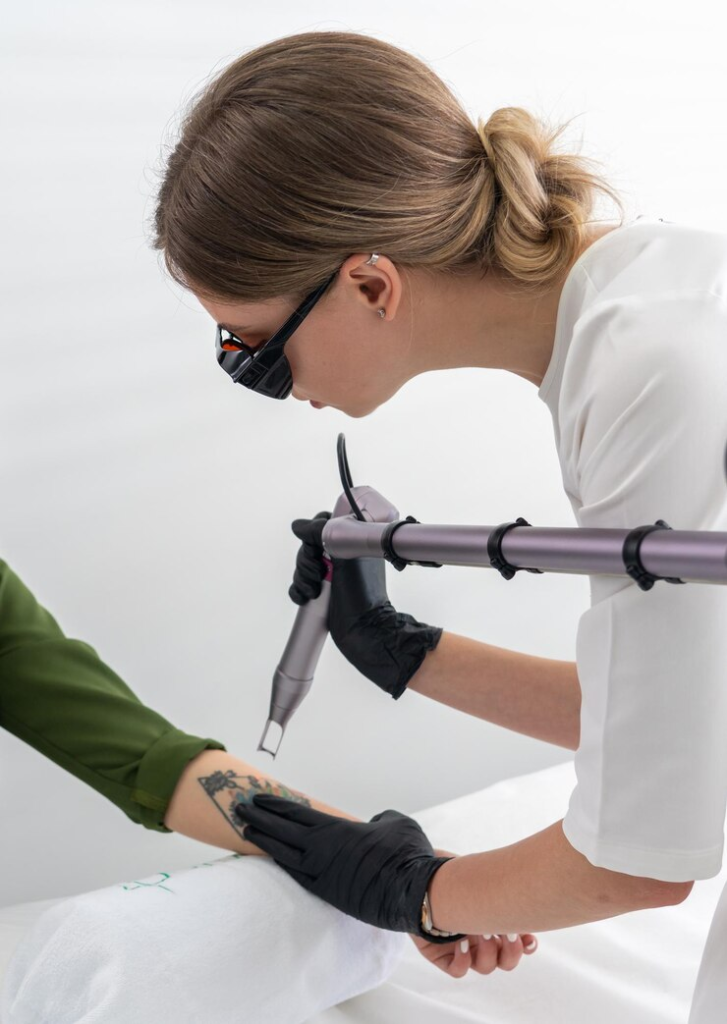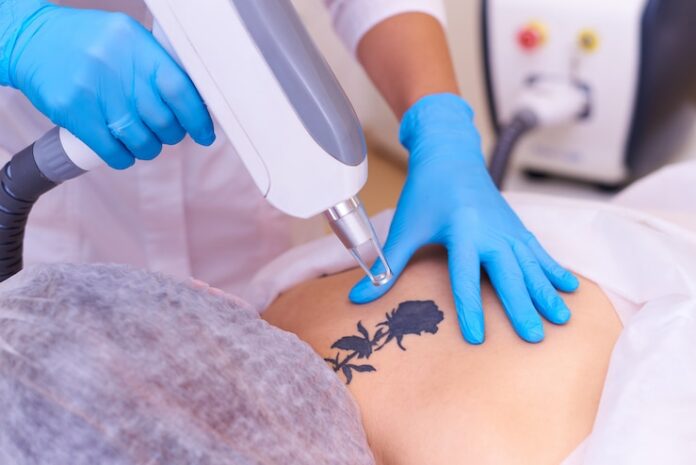Tattoo regret is more common than you might think. While some people opt for complete removal, others choose to modify their existing tattoo by lightening it for a fresh, new cover-up design. This is where Laser Tattoo Removal proves to be a powerful tool in modern aesthetic treatments. Designed to break down stubborn ink particles within the skin, this treatment has gained popularity among individuals seeking seamless and effective tattoo adjustments. Whether you’re dealing with dark, bold designs or intricate colors, this technique can help fade the ink just enough for a professional tattoo artist to create a clean, flawless cover-up. This approach is especially popular among those considering Laser Tattoo Removal in Dubai, where advanced technology meets expert care.
How Does Laser Tattoo Removal Lighten Ink?
The science behind laser tattoo removal lies in targeting the ink pigments embedded within the dermis. During treatment, concentrated pulses of laser light penetrate the skin and fragment the ink particles into smaller components. These microscopic fragments are then naturally eliminated by the body’s immune system over time.
For those planning a cover-up, the goal isn’t to completely erase the existing tattoo but to reduce its visibility. Lightening the ink allows a tattoo artist to work over a faded base, giving them greater flexibility in choosing new colors and designs. This selective removal ensures that dark patches or dense areas are sufficiently lightened without over-treating sections meant to remain or be incorporated into the new artwork.

Why Lighten a Tattoo for a Cover-Up?
Cover-up tattoos require a carefully planned canvas. Dark, heavily pigmented designs can limit what a tattoo artist can achieve. If the original tattoo is too dark or dense, new ink may not effectively conceal it, leading to dull results or visible remnants of the old design.
Lightening with laser treatment provides the following advantages:
- Allows for a broader range of colors, including lighter shades.
- Reduces the risk of old designs bleeding through new work.
- Provides a more even skin tone for detailed, precise cover-up work.
- Ensures a more vibrant, clean, and lasting cover-up tattoo.
How Many Sessions Are Required to Lighten Ink for a Cover-Up?
The number of laser sessions needed for lightening depends on several factors:
- The age and depth of the original tattoo.
- Ink density and color (darker shades typically require more sessions).
- The individual’s skin type and healing response.
Doctors usually recommend a personalized consultation to assess the tattoo and plan an appropriate lightening schedule. Typically, fewer sessions are needed for lightening than for full removal since the goal is not complete ink clearance but strategic fading. Treatments are spaced several weeks apart to allow the skin to heal and the body to gradually process fragmented ink particles.
What Happens During the Lightening Procedure?
During a lightening session, a qualified practitioner uses a high-intensity laser device tailored to the ink’s color and skin type. Different wavelengths target specific ink pigments, ensuring precise and safe treatment.
The doctor moves the laser handpiece across the tattooed area, delivering quick bursts of light that shatter the ink particles beneath the skin’s surface. Protective measures, such as cooling devices or topical agents, are often applied to enhance comfort and minimize post-treatment redness.
Unlike full removal procedures, the treatment intensity is carefully adjusted to fade the ink gradually, making it ideal for prepping the skin for a cover-up. Doctors emphasize post-treatment care to promote healthy skin recovery and maintain the best foundation for the upcoming tattoo work.
Benefits of Lightening Tattoos for Cover-Ups
Opting for laser lightening before a cover-up offers several significant benefits:
- Expanded Creative Options: Faded ink allows tattoo artists to use a wider color palette, including pastels and lighter tones.
- Cleaner, Sharper Designs: Reduced ink density prevents the old tattoo from interfering with new artwork, ensuring crisp lines and vibrant hues.
- Reduced Risk of Ghosting: Lightening minimizes the chances of old designs showing through over time.
- Customized Fading: Doctors can selectively lighten specific areas, preserving parts of the design if desired.
- Improved Skin Texture: Modern laser treatments often enhance skin quality by stimulating collagen production.
Can All Tattoos Be Lightened for a Cover-Up?
While most tattoos respond well to laser lightening, certain factors can influence the outcome:
- Ink Color: Some pigments, like greens, blues, and yellows, can be more resistant.
- Tattoo Age: Older tattoos often fade more easily due to natural ink breakdown.
- Skin Tone: Different skin types may require specific laser settings for safe and effective results.
A professional consultation is essential to determine feasibility. Experienced doctors evaluate the tattoo’s complexity and the client’s skin characteristics before customizing the lightening plan.
FAQs
How long should I wait after lightening sessions before getting a cover-up tattoo?
It’s generally recommended to wait 6 to 8 weeks after your final laser session to allow the skin to fully heal and for ink particles to continue fading.
Does laser tattoo lightening hurt?
Most people experience a sensation similar to a rubber band snapping against the skin. Doctors typically offer cooling techniques or numbing options to enhance comfort.
Can I request partial lightening on specific areas of my tattoo?
Yes — skilled doctors can target specific sections of a tattoo, lightening areas that need it while preserving other parts for incorporation into the new design.
Is there a risk of scarring after laser lightening treatments?
When performed by experienced professionals using advanced equipment, the risk of scarring is minimal. Proper aftercare further reduces any potential complications.
Can laser tattoo removal completely fade a tattoo for a cover-up?
While full removal is possible, most clients seeking a cover-up only require the ink to be lightened. This creates a workable base for the tattoo artist without needing total ink clearance.
Conclusion
Laser tattoo removal has transformed the possibilities for tattoo cover-ups by providing a reliable method for selectively lightening existing ink. By carefully fading dense, dark, or outdated designs, this treatment enables artists to work over a clean, even canvas, delivering stunning, personalized results. In the hands of experienced doctors, laser lightening ensures safe, effective, and customizable outcomes tailored to each individual’s skin type and tattoo design. Whether you’re looking to transform an old tattoo or correct a past decision, Laser Tattoo Removal offers an advanced, professional approach to help you achieve your ideal ink story.
































